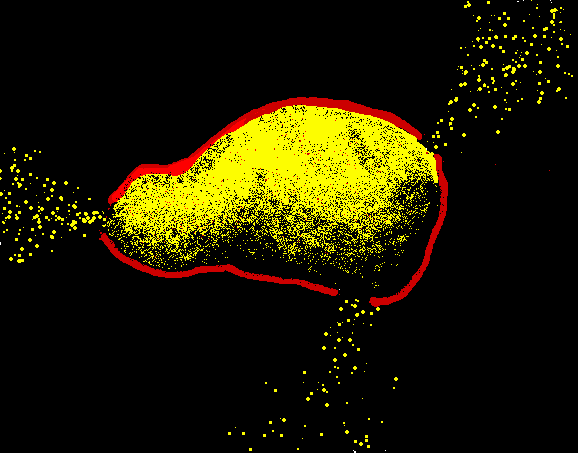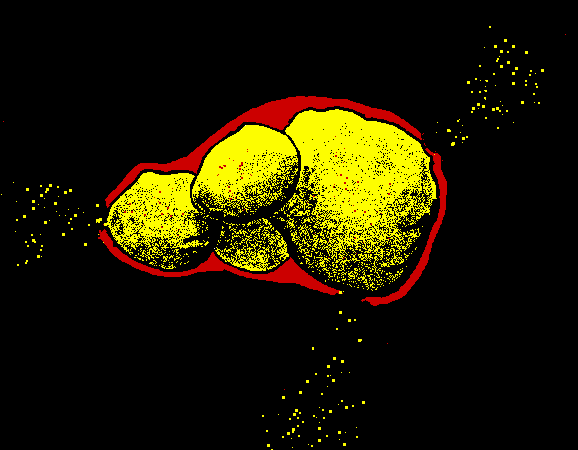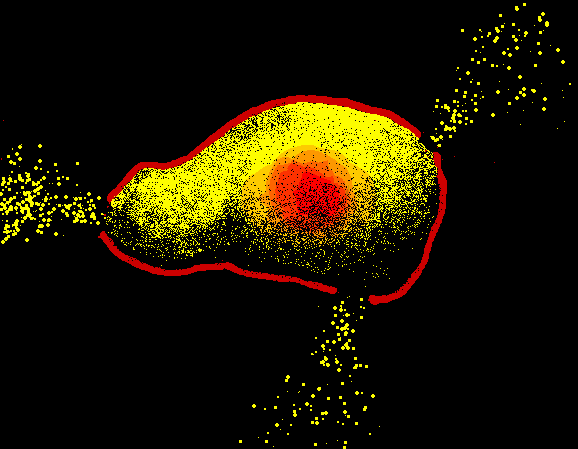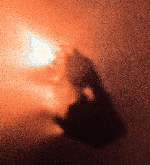 Monolithic Nucleus |
 Multi-component Nucleus |
 Differentiated Nucleus |
|---|
 Monolithic Nucleus |
 Multi-component Nucleus |
 Differentiated Nucleus |
|---|
We have many ideas but not many constraints on the interior structure
of cometary nuclei. What little we know is inferred from observations
of comets that split, and from our limited knowledge of the way in which
comets accrete in the protoplanetary nebula.
Monolithic Nucleus
Perhaps the simplest idea is that the nucleus is a single, coherent
body of uniform internal composition. There is a mantle (red in the
figure) composed of rubble exposed by sublimation. The monolithic
nucleus would be strong, so it is not clear that his model can explain
observations of comets splitting in response to tiny tensile forces.
Multi-component Nucleus
The multi-component nucleus (also known as Rubble Pile nucleus)
consists of many structurally independent bodies loosely held together
by mutual gravitational attraction. There would be many more pieces
than in the sketch above - I couldn't draw them, though. The bodies
are sometimes
identified with individual precursor planetesimals from the
protoplanetary disk. Some people like to think that the sub-units
within the nucleus might be planetesimals from very different original
locations
in the solar nebula. If so, they might have different compositions.
A mantle envelopes the whole assemblage as with the Monolithic nucleus model.
Because the building blocks are not tightly bound, a multi-component
nucleus could be very weak. This fits with what we think we know about
the strengths of comets.
Differentiated Nucleus
Some people have speculated that nuclei might be partially differentiated,
just as the Earth has differentiated into an iron core + rock mantle
structure. I don't expect such dramatic differentiation in comet
nuclei because these objects are mostly too small to generate very
high internal temperatures. However, radioactive heating from
long-lived nuclei of Potassium, Thorium, Uranium might be sufficient
to drive internal migration of the most volatile ices (e.g. CO, N2)
away from the "core" (shaded pink in the 3rd panel, above). In
smaller comets, the short-lived Al26 nucleus could supply the heat.
Real Nucleus
Very probably, real comet nuclei incorporate features of all the
models shown here. Small nuclei may be monolithic, while larger
ones consist of agglomerated pieces. Cometary material is such a
poor conductor of heat that it is entirely possible that large
nuclei possess a core depleted of the most volatile ices. The
challenge is to take observations that constrain the many models.
 |
 |
|
| Nucleus | Comet | Jewitt |
|---|